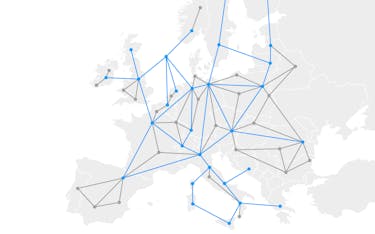The grid and its secure operations are fundamental prerequisites for prosperity and a high quality of life in Switzerland. From healthcare and business to individual households, today’s society depends on electricity being available at all times, even in the most remote locations. The grid enables the electricity that is produced to be used everywhere, around the clock, by connecting power plants, storage facilities and consumers. The Swiss transmission grid, which functions like a network of «electricity highways», has an important role to play. As the backbone of a secure supply of electricity, it makes a key contribution to achieving the goals of the Energy Strategy 2050, which the Swiss population approved in a referendum.
Swissgrid has updated its long-term grid plan to ensure that the transmission grid meets future requirements. Swissgrid has identified 31 grid projects which must be implemented by the target year 2040 and which, along with the existing grid, will then form the «grid of the future».
The grid of the future in brief
- The transmission grid is the backbone of a secure supply of electricity in Switzerland. It must continue to be developed so that it meets future requirements.
- By preparing the grid of the future, Swissgrid is creating the basis for the successful transformation of the energy system.
- This transformation is being driven by the decarbonisation of transport, electricity and heat generation, the decentralisation of electricity generation, and digitalisation.
- Swissgrid has identified 31 major grid enhancement and expansion projects in the Swiss extra-high-voltage grid that need to be implemented by 2040.
- Swissgrid is preparing the transmission grid for the energy future with investments totalling around CHF 5.5 billion by 2040.
Progress needs electricity – and a strong grid
Switzerland’s electricity system is in the midst of the greatest upheaval in its long and successful history. There are three main reasons for this:
- Decarbonisation: the fossil fuels used for heating and mobility are being replaced by renewable energies. Heat pumps, electromobility and data centres are intensifying electricity requirements.
- Decentralisation: Switzerland is gradually phasing out nuclear energy, meaning that more and more electricity will be generated in decentralised, smaller production plants, e.g. using solar and wind energy.
- Digitalisation: digitalisation is boosting automation, flexibility and efficiency in the energy system.
The change in the energy mix – with increasingly volatile electricity generation due to the growing share of solar and wind energy, electricity storage in batteries and pumped storage power plants, as well as growing electricity consumption – pose additional challenges for secure grid operation. This situation is aggravated by the increase in large-scale, volatile international electricity flows. All of these factors have far-reaching consequences for the electricity industry in Switzerland and throughout Europe, and therefore also for the Swiss transmission grid.
The energy world of tomorrow
In the energy system of the future, production plants, storage systems and large consumers (heat pumps, electric cars, data centres, etc.) will communicate with and adjust to each other automatically. Digitalisation and the use of Internet of Things (IoT) technologies will help to keep generation and consumption balanced at all times in order to control the grid efficiently and keep it stable. A powerful grid with additional capacities will form the basis for this energy system and connect all the important elements. However, there are still a few hurdles to overcome on the path towards this energy world of tomorrow.
Challenges for the grid of the future
- Elimination of power plants with secure, controllable output (nuclear power, coal)
- Expansion of electricity generation from renewable energies
- Integration of decentralised, flexible resources (photovoltaics and home batteries) into the energy system
- Integration of electromobility and decentralised large-scale batteries into the energy system
- Comprehensive digitalisation and automation to navigate growing complexity in the energy system
- Rise in electricity consumption due to population and economic growth, data centres, AI, etc.
- Volatile energy policy framework and regulatory environment
- Greater exclusion of Switzerland from EU grid and market mechanisms and bodies
- Sluggish expansion of grids and a lack of acceptance for grid projects
- Integration of Switzerland into the planned European supergrid and the European electricity market
Everyone can relieve the burden on the grid
The need to expand the grid for the energy world of tomorrow can be minimised by introducing various measures. They include using storage systems intelligently, not feeding production peaks from solar and wind power plants into the grid when there is a surplus of electricity, and adjusting consumption behaviour to the energy supply. Digitalisation facilitates the automation of a household’s own consumption by coordinating the electricity consumption of heat pumps and electric vehicles during times of high photovoltaic feed-in. In short, to reduce the load on the grid, electricity needs to be consumed when and where it is generated. Everyone can contribute to this.
Swissgrid is shaping the grid of the future
The transformation of the energy system requires a more advanced grid. This is because its conversion and expansion has slowed down in recent decades. Only a third of Swissgrid’s 6,700-kilometre transmission system was built after 1980. Current congestion, as well as any future threats of congestion, must be eliminated to guarantee the safe, powerful and efficient operation of the Swiss electricity system. To achieve this, we need to continue developing the grid.
Swissgrid periodically draws up a multi-year plan for long-term grid development.
Opinions on the grid of the future
Safeguarding Switzerland’s energy future in a sustainable manner
The grid is the backbone of a secure supply of electricity in Switzerland. This means that far-sighted planning and development of the grid are in the interest of the national economy and the entire Swiss population. Business and political figures, as well as members of the population, explain why the grid is important in this context and for them personally. Because the grid concerns us all.
Links & Downloads
Links
The Federal Council approves the Scenario Framework Switzerland (admin.ch – in German)


















